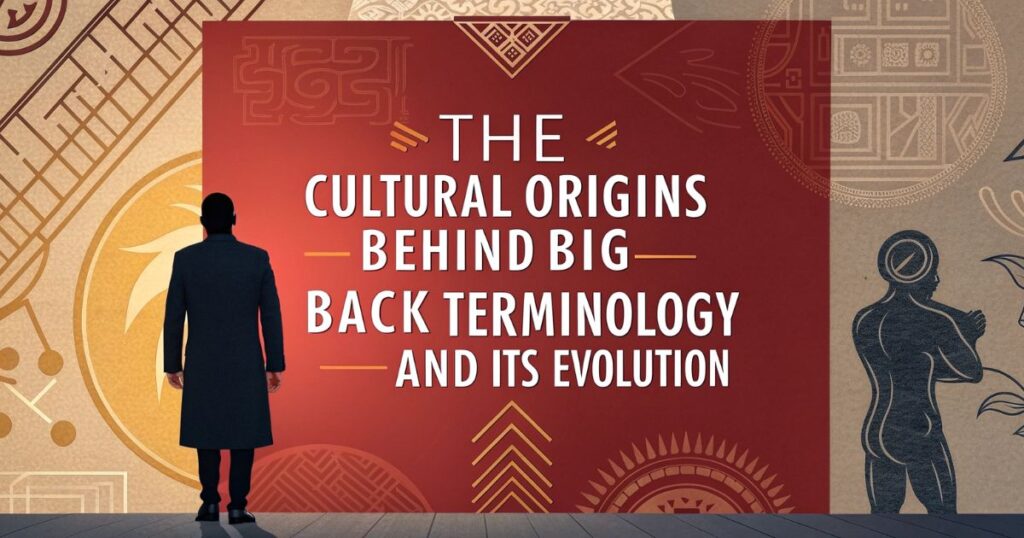Modern slang evolves faster than most dictionaries can track, and “big back” represents one of those fascinating linguistic shifts that’s captured American youth culture.
You’ve probably encountered this term scrolling through TikTok, Instagram, or overheard it in casual conversations without fully grasping its nuanced implications.
Understanding big back meaning requires diving deeper than surface-level definitions to explore the cultural currents shaping how we communicate about bodies, food, and identity.
What Does “Big Back” Actually Mean in Today’s Slang Dictionary
Big back fundamentally refers to someone with a large appetite or tendency to eat substantial quantities of food. However, this definition barely scratches the surface of its actual usage patterns.
The term operates on multiple semantic levels. Literally, it suggests someone whose back appears wide or broad, often implying overall body size. Figuratively, it’s become shorthand for describing eating behaviors rather than physical attributes.
Contemporary usage typically involves playful commentary about someone’s relationship with food. When someone says “you’re being a big back right now,” they’re usually referencing enthusiastic eating rather than making direct body commentary.
The phrase carries distinct connotations depending on context, tone, and relationship dynamics between speakers. Among close friends, it functions as lighthearted teasing. In other contexts, it can feel more pointed or potentially hurtful. If you want to read Condolence Messages for Loss of Father then visit this link.
The Cultural Origins Behind Big Back Terminology and Its Evolution

Big back slang emerged from African American Vernacular English (AAVE) communities, particularly gaining traction through social media platforms around 2022-2023.
The term’s evolution reflects broader patterns of how AAVE expressions enter mainstream American vocabulary. Initially used within specific cultural communities, it spread rapidly through viral content creators and meme culture.
Historical precedent exists for body-related slang terms that eventually transcend their original contexts. Big back follows similar trajectories as expressions like “thick” or “snack,” which evolved from descriptive terms to complex cultural signifiers.
Social media algorithms amplified the phrase’s reach exponentially. TikTok videos featuring big back commentary regularly garnered millions of views, cementing its place in Gen Z vocabulary.
The term’s migration pattern demonstrates how digital platforms accelerate linguistic change, allowing regional expressions to achieve national recognition within months rather than decades.
How Big Back Differs from Traditional Body-Shaming Language
Traditional body-shaming typically targets appearance directly, using explicitly negative terminology designed to cause emotional harm. Big back operates through different mechanisms entirely.
The phrase often functions as observational humor rather than deliberate cruelty. Users frequently apply it to eating situations rather than physical descriptions, creating semantic distance from pure appearance-based criticism.
Context sensitivity distinguishes big back from harsher alternatives. The same person might use “big back” playfully while avoiding more obviously offensive language, suggesting awareness of different harm levels.
Research indicates that indirect body commentary can feel less threatening than direct insults. However, this doesn’t eliminate potential negative impacts on recipients.
The term’s humor-coded delivery sometimes masks underlying judgments about eating behaviors, creating complexity around its actual intentions and effects.
Social Media Platforms Where Big Back Slang Thrives Most
TikTok dominates big back content creation, with hashtags generating billions of collective views. The platform’s short-form video format perfectly suits the phrase’s punchy, reaction-based usage patterns.
Instagram Stories and Reels feature frequent big back references, particularly in food-related content. Users often apply the term to their own eating behaviors in self-deprecating ways.
Twitter conversations incorporate big back into broader discussions about food culture, body image, and social commentary. The platform’s text-based format allows for more nuanced exploration of the term’s implications.
YouTube creators have produced extensive content analyzing big back phenomena, contributing to its mainstream recognition and cultural documentation.
Snapchat usage tends toward more intimate friend-group contexts, where big back appears in private conversations and casual commentary about shared meals or social situations.
Why Gen Z and Millennials Embrace Big Back as Humor vs Insult
Generational humor patterns heavily influence how younger Americans interpret and deploy big back terminology. These age groups often prefer indirect, ironic commentary over explicit criticism.
Meme culture literacy enables sophisticated understanding of contextual meaning. Gen Z users particularly excel at distinguishing between playful usage and genuine mockery based on subtle delivery cues.
The phrase aligns with broader body-positive movements that encourage food enjoyment without shame. Many users reclaim potentially negative terminology by using it confidently about themselves.
Social bonding occurs through shared linguistic codes. Using big back appropriately demonstrates cultural fluency and group membership among peer networks.
However, generational differences create interpretation gaps. Older adults might perceive big back usage as more harmful than intended, while younger users view it as relatively benign social commentary.
Regional Variations of Big Back Usage Across Different US Communities
Southern communities often incorporate big back into existing food-appreciation vocabularies, blending it with regional expressions about hearty eating and hospitality culture.
West Coast usage tends toward more ironic, self-aware applications, reflecting broader cultural patterns around body image discourse and wellness culture.
Urban centers see higher concentrations of big back usage, particularly among diverse youth populations where AAVE expressions gain rapid adoption across ethnic communities.
Midwestern applications sometimes carry different emotional weight, potentially reflecting regional attitudes about directness, politeness, and social commentary styles.
Rural areas show more varied reception, with some communities embracing the term while others resist what they perceive as inappropriate body commentary.
The Psychology Behind Using Big Back in Friend Groups and Social Circles
In-group bonding frequently involves shared linguistic practices that demonstrate social cohesion and mutual understanding. Big back usage serves this function effectively within established friend networks.
Teasing behaviors among close friends operate under different psychological rules than interactions with acquaintances or strangers. Familiar relationships create safety buffers that allow potentially sensitive commentary.
Social hierarchy dynamics influence big back deployment patterns. Individuals with higher group status might use the term more freely, while others gauge acceptance levels before participating.
Emotional regulation sometimes involves humor as a coping mechanism. Some people use big back references to address their own food relationships through externalized commentary.
Boundary testing occurs when individuals experiment with big back usage to understand group norms and acceptance levels around body-related humor.
When Big Back Crosses the Line from Playful Banter to Harmful Commentary
Repetitive targeting of specific individuals transforms playful usage into potential harassment. When someone consistently becomes the “big back” focus, intentions shift from humor to cruelty.
Power imbalances create problematic dynamics when authority figures, popular individuals, or those with social advantages use big back terminology against vulnerable targets.
Public humiliation scenarios, particularly on social media, escalate beyond friendly teasing into potentially damaging exposure that reaches unintended audiences.
Emotional distress indicators include withdrawal, defensive responses, or explicit requests to stop. Continuing big back usage despite these signals reveals harmful intentions.
Context collapse occurs when private friend-group humor becomes public content, changing the meaning and impact of originally benign commentary.
How Big Back Relates to Food Culture and Eating Habits in American Society
American food culture contains complex relationships between abundance, guilt, and identity that big back terminology both reflects and reinforces.
Diet culture influences create underlying tensions around eating behaviors that make seemingly innocent commentary carry heavier emotional weight than intended.
Social eating dynamics involve performance aspects where big back references become part of shared meal experiences and food-related social media content.
Regional food traditions intersect with big back usage patterns, particularly in areas where generous eating is culturally celebrated versus regions emphasizing restraint.
Generational shifts in food attitudes affect how big back terminology is received, with younger Americans often more comfortable with food-positive language than older generations.
Celebrity Reactions and Public Figures Who’ve Addressed Big Back Comments
Several social media influencers have directly addressed big back commentary directed at them, using these moments to discuss broader issues around body image and online harassment.
Music artists have incorporated big back references into lyrics and social media content, contributing to the term’s mainstream recognition and cultural legitimization.
Comedy personalities frequently use big back humor in their content, though reception varies based on their relationship with audiences and delivery style.
Body positivity advocates have offered mixed responses to big back phenomena, some embracing its food-positive aspects while others critique its potential for harm.
Public health experts generally avoid engaging directly with slang terminology but have addressed broader patterns of body-related social media commentary in their professional communications.
Responding to Big Back Comments: Healthy Coping Strategies That Actually Work
Direct communication often proves most effective when big back usage feels uncomfortable. Clearly expressing boundaries helps establish appropriate interaction patterns with others.
Reframing techniques can transform potentially negative commentary into neutral or positive interpretations, reducing emotional impact while maintaining social relationships.
Selective engagement involves choosing when to respond versus when to ignore big back references, based on context, relationship importance, and personal energy levels.
Support network utilization provides external perspective and emotional validation when dealing with challenging social dynamics around body-related commentary.
Professional guidance becomes valuable when big back or similar commentary significantly impacts self-esteem, eating behaviors, or social comfort levels.
The Difference Between Self-Deprecating Big Back Jokes and External Criticism
Self-deprecating usage typically involves individuals making big back references about themselves, maintaining control over the narrative and timing of such commentary.
External criticism occurs when others apply big back terminology without invitation, creating different power dynamics and emotional impacts for recipients.
Agency differences are crucial – choosing to use big back about yourself versus having it applied to you represent fundamentally different psychological experiences.
Defensive mechanisms sometimes involve preemptive self-deprecation to avoid external big back commentary, though this strategy can reinforce negative self-perceptions over time.
Social protection may occur when friends use big back references first to prevent potentially harsher external commentary from others.
Educational Approaches for Parents Dealing with Big Back Terminology at Home
Age-appropriate conversations help children understand big back meaning while developing critical thinking skills about language, context, and social impact.
Media literacy education enables young people to recognize how social media amplifies certain terms and influences peer communication patterns around body image.
Family communication norms should address appropriate language use while acknowledging that slang terms like big back exist in broader cultural contexts.
Positive body image reinforcement counteracts potentially negative messages that children might internalize from big back usage in their social environments.
Collaborative rule-setting involves family discussions about acceptable language use rather than purely authoritarian approaches that might increase rebellious behavior.
Professional Workplace Implications When Big Back Language Enters Office Culture
Workplace harassment policies may need updates to address evolving slang terminology that could create hostile environments, including big back references.
Generational workplace dynamics create situations where younger employees might use big back language that older colleagues find inappropriate or offensive.
Professional development training should include discussions about appropriate workplace language and the potential impacts of body-related commentary, even when intended humorously.
HR documentation becomes important when big back usage contributes to workplace conflict or creates documented patterns of inappropriate behavior.
Cultural competency requires understanding how terms like big back might affect different employees based on their backgrounds, experiences, and sensitivities.
Body Positivity Movement’s Stance on Big Back and Similar Descriptive Terms
Movement diversity means no single position exists on big back terminology, with different advocates holding varying perspectives on its potential benefits versus harms.
Reclamation strategies sometimes involve embracing terms like big back as ways to remove their negative power, though this approach remains controversial within body-positive communities.
Intersectional considerations recognize how big back usage might affect different groups disproportionately based on race, gender, size, and other identity factors.
Educational priorities focus on helping people understand the complex relationships between language, body image, and social justice rather than simply prohibiting specific terms.
Evolving perspectives reflect ongoing debates within body positivity movements about the most effective approaches to creating inclusive, supportive social environments.
Alternative Expressions That Convey Similar Meaning Without Potential Offense
Food enthusiasm descriptors like “foodie” or “appetite appreciation” maintain positive connotations while describing similar eating behaviors without body references.
Neutral observational language such as “enjoying your meal” or “eating well” provides commentary options that avoid potentially sensitive territory entirely.
Celebratory food terms like “feast mode” or “food adventure” frame enthusiastic eating as positive experiences rather than potentially problematic behaviors.
Individual preference acknowledgment through phrases like “that’s their style” or “different appetite levels” normalizes eating variation without judgment implications.
Context-specific alternatives vary based on relationships and situations, requiring social awareness to select appropriate terminology for different interactions.
Research Data on How Big Back Language Affects Self-Esteem and Body Image
Limited academic research exists specifically on big back terminology due to its recent emergence, though broader studies on body-related language provide relevant insights.
Social media impact studies suggest that repeated exposure to body-commentary, even when intended humorously, can influence self-perception and eating behaviors over time.
Adolescent psychology research indicates that peer language around bodies and food significantly affects identity development and self-esteem during crucial developmental periods.
Cultural linguistics data shows how slang terms can normalize certain attitudes and behaviors while potentially marginalizing others, creating subtle but persistent social pressures.
Longitudinal studies tracking the effects of body-related social media commentary are ongoing, with preliminary results suggesting complex relationships between language exposure and psychological outcomes.
Future Predictions for Big Back Slang Evolution in American Vernacular
Linguistic lifecycle patterns suggest big back will likely evolve, potentially becoming either more mainstream and normalized or gradually replaced by newer terminology.
Cultural integration may see big back entering broader American vocabulary beyond its current primarily youth-oriented usage, though meaning might shift during this process.
Backlash potential exists as awareness of the term’s implications grows, possibly leading to decreased usage or more careful contextual application.
Regional persistence might create geographic variations where big back remains popular in some areas while disappearing from others, reflecting broader cultural differences.
Digital platform changes will continue influencing how big back and similar terms spread, evolve, and potentially fade from popular usage patterns.
Frequently Asked Questions
What does “big back” mean in slang?
Big back refers to someone with a large appetite or who eats substantial amounts of food, though it can also reference physical appearance. The term originated from AAVE communities and spread through social media platforms like TikTok and Instagram. Context and relationship dynamics heavily influence whether it’s perceived as playful teasing or potentially offensive commentary.
Conclusion
Big back meaning encompasses far more complexity than its surface definition suggests, reflecting broader American conversations about food, bodies, and social communication. This slang term serves as a fascinating case study in how language evolves through digital platforms while carrying cultural weight that extends beyond simple definitions. Understanding these nuances helps navigate modern social interactions while remaining sensitive to the diverse ways people experience and interpret body-related commentary.
More Posts
Voyeurism Term in English: Simple Explanation & Examples
What Does It Symbolize When a Ladybug Lands on You
FYP Meaning: All About the “For You Page” Explained

Welcome to Brightnis! I am the admin and creator of this platform. I love questioning ideas and exploring different situations. My goal is to encourage critical thinking and help people see things from new perspectives. Join me in discussing thought-provoking topics and finding unique solutions to everyday challenges!





![220+ Best Savage Captions And Quotes For Instagram [2025] Best Savage Captions And Quotes For Instagram](https://brightnis.com/wp-content/uploads/2025/05/Building-my-empire_-one-brick-at-a-time-150x150.webp)
